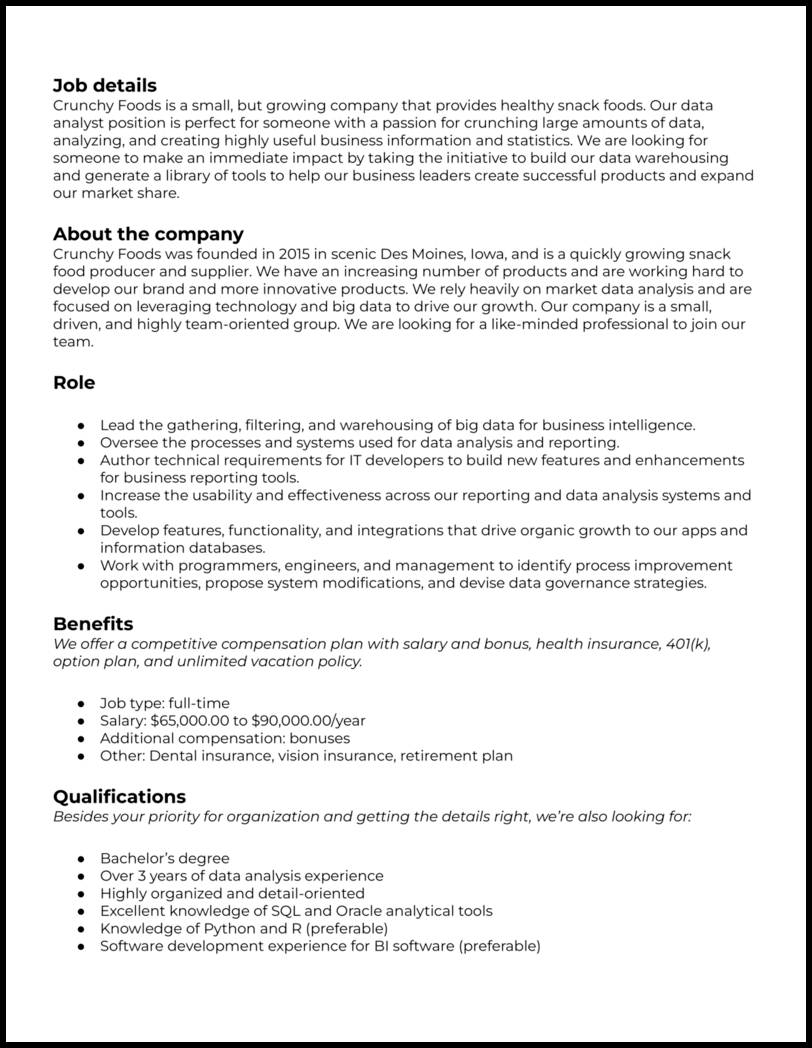Data analysis might not sound riveting, but it’s a huge part of making sound business decisions. That’s why you’re doing the smart thing and hiring a data analyst, after all! But writing a data analyst job description that attracts top applicants is a tall order.
A great data analyst should have data processing software skills and knowledge of business development strategies. They should also be able to collaborate effectively with other data analysts to generate reports, monitor KPIs, and transform data into useful information.
With so much to include, how do you write a job ad that gets the best data analyst resumes? We have great examples and advice for creating excellent job descriptions so that you can attract and hire the right people.
How to Write a Data Analyst Job Description

Writing a great job description for any role can be challenging, but it’s especially difficult when hiring a data analyst. Data analysts handle a broad selection of skills that differ from company to company.
It’s easy to fall into the trap of creating a lengthy description to try and cover everything, but remember your goal: making applicants want to apply.
You’re selling the job and your organization, and you’ll get a lot better quality data analyst resumes and data analyst cover letters when your job description is brief, succinct, and informative. Strive to emulate what data analysts do: distilling the essentials into the most valuable information.
You should include the most pertinent job requirements for the role, but there’s a key component most data analyst job descriptions miss: including why you’re hiring a data analyst.
Use an example of a gap you want to fill or what challenge you want your data analyst to address. If you’re increasing resources, capacities, or capabilities, then talk about that. Be specific, short, and honest!
Strive to emulate what data analysts do: distilling the essentials into the most valuable information.
Length notwithstanding, did you know that the specific words you use can turn away applicants? To ensure your job descriptions aren’t excluding diverse candidates, use words and phrases that aren’t biased.
The University of Arizona’s writing center stresses the importance of picking “the word that most clearly conveys your meaning”. When writing your data analyst job description, consider the connotation of each word choice (like how some words are considered gendered).
So before you post your job description, take the time to revise and edit. You’ve worked hard on your job description, so make sure it’s the highest caliber it can be before you hit “submit”.
Some things to watch for:
Factual errors (like a dated salary)
Gendered language
Unnecessary adverbs (like “very” or “as needed”)
Confusing or lengthy phrases
Overused jargon or buzzwords
Lastly, copy-edit to catch typos, grammatical errors, and missed punctuation. Data analysts are detail-driven, so make sure you get the small things right! When you’re satisfied, submit your post to boards with confidence, knowing that your job description will speak to high-quality talent.
Your Data Analyst Job Description Layout

Need a bit of help structuring your job description? Use our outline below to make sure you cover all the necessary elements for your job posting.

Job details
This is a quick introductory section for your job opening and company. Keep it brief, but remember that your goal is to sell the role and your organization. Write one or two sentences about the what and why of the data analyst role, including why you’re hiring a data analyst.

About the company
This is where you’ll give job seekers more details about your company. If your company is small and not well known, this is where you tell them why they should want to work there.
More than just your history, data analysts will want to know how your company views leveraging information technology and big data. So give applicants a brief synopsis of how your company approaches the use of data in their strategy and how the data analyst role fits in.

Roles
This section may also be titled “Roles” or “Responsibilities” or “Requirements.” Whatever it’s called, this should be a bulleted list of the tasks involved in the position. Keep this list relatively short, but make sure you include anything unique to the role for your company. Use active verbs, avoid too much jargon, and be specific.
- Lead the gathering, filtering, and warehousing of big data for business intelligence
- Oversee the processes and systems used for data analysis and reporting
- Author technical requirements for IT developers to build new features and enhancements for business reporting tools
- Understand database designs (logical/physical) that support complex business processes and related applications
- Leverage advanced SQL expertise to effectively query and navigate across multiple data domains to perform data analysis and create findings

Qualifications
This is a key section that quickly tells the applicant whether they’re a good fit. Include the absolute “must-haves” for the position. Typically, these are things like education, years of experience, certifications, and specialization requirements.
For soft skills, use relevant personality words like “creative,“ “self-motivated,” “organized,” and “reliable,” but avoid too many. Instead, include any special and non-standard qualifications for your company. As with every section of your job description, be brief, specific, and clear.
- Bachelor’s degree in mathematics, statistics, or related field
- 3+ years of data analysis experience
- 2+ years of database experience
- SAS Certified Advanced Analytics Professional Using SAS 9 (preferred)
- Extensive experience developing reports and managing reporting tools
- Strong communication and leadership skills

Salary and benefits
You can place this section just about anywhere (although we don’t recommend putting it in your introduction). You may want to have this early in your job description if your benefits are a major selling point for the position, but so long as you include this section, its position is flexible.
Include a salary range, insurance options, and anything that differentiates your company benefits from other companies. For example, does your business have free lunches every Friday? Maybe you provide access to a company gym. Be clear and unique (and most of all, honest).
Roles and Responsibilities of a Data Analyst

We’ve compiled a list of some sample roles a data analysis professional might fulfill so you can easily write your job description. One single data analyst might not fill all these roles, but this will serve as a general source.

Data acquisition
Great data analysts have an investigative nature that allows them to review large databases and data sets from many sources to extract pertinent information in response to a particular question.
- Identify internal and external sources of data that can be used as well as to detect important patterns and trends in the data
- Determine the processing methodologies to best transform data into usable business intelligence
- Think critically about how data is used, and assess and quantify strengths, weaknesses, and opportunities posed by data sources and processing
- Continually seek to find new data sources, ways to improve data processing, and new technologies to better use data

Problem-solving
The data analyst function helps to define how data can be used to make the organization successful. They provide expertise and guidance to the business on how to best use data to drive processes to support the business strategy.
- Study business challenges, research relevant data processing techniques, and determine solutions (leveraging data analysis)
- Build, maintain, and enhance technology systems (databases, warehouses, interfaces, reporting, etc.) for obtaining and processing data
- Identify technical issues in data acquisition, processing, and utilization, and assess and resolve any issues found
- Continually work with the business to review and assess business processes about how data is gathered, analyzed, and used

Communication & reporting
A successful data analyst must have excellent written and verbal communication skills that enable them to present complicated information and findings to all levels within the company.
- Collaborate with teams, colleagues, departments, and all other stakeholders to effectively understand business processes, and translate technical information into coherent business information
- Compile written analyses and reports regarding certain data figures
- Effectively translate complex data and findings into useful information for all business stakeholders
- Facilitate business communication and reporting for internal and external stakeholders

Leadership
The best data analysts have a very team-oriented mindset and work extremely well with other employees to find answers by leveraging data.
- Work with business owners to understand business processes in great detail
- Drive data analysis efforts as a subject-matter expert, leader, and process owner
- Consult with and guide all stakeholders (internal and external) regarding best practices and effective usage of data to improve business processes
- Lead teams and projects to productively leverage data gathering and analysis to successfully complete tasks, initiatives, and projects

Training
Data analysts should demonstrate a strong interest in continued education and seek certification courses related to statistics or data analytics to improve their professional capabilities. Technology, data sources, and related best practices are constantly changing and evolving.
- Continually research and stay up to date on the current state of data analysis
- Maintain professional training hours, and keep certifications current
- Engage with the business and stay in tune with what stakeholders are doing with the data, information, and reporting provided to meet business needs
- Promote ongoing training and technical education for data analysis professionals and business process owners to enhance and evolve data utilization








